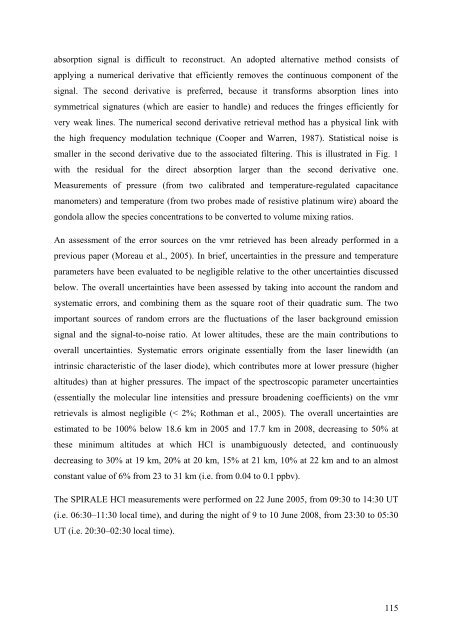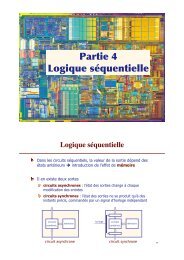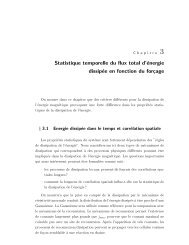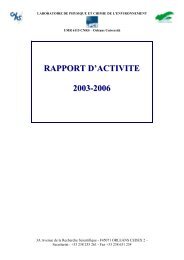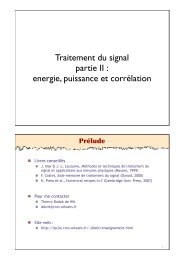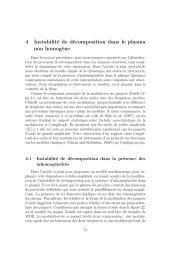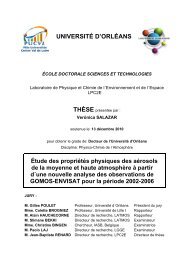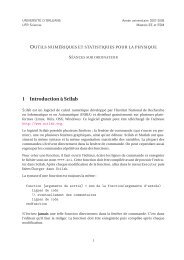UNIVERSITÉ D'ORLÉANS - Laboratoire de physique et chimie de l ...
UNIVERSITÉ D'ORLÉANS - Laboratoire de physique et chimie de l ...
UNIVERSITÉ D'ORLÉANS - Laboratoire de physique et chimie de l ...
Create successful ePaper yourself
Turn your PDF publications into a flip-book with our unique Google optimized e-Paper software.
absorption signal is difficult to reconstruct. An adopted alternative m<strong>et</strong>hod consists of<br />
applying a numerical <strong>de</strong>rivative that efficiently removes the continuous component of the<br />
signal. The second <strong>de</strong>rivative is preferred, because it transforms absorption lines into<br />
symm<strong>et</strong>rical signatures (which are easier to handle) and reduces the fringes efficiently for<br />
very weak lines. The numerical second <strong>de</strong>rivative r<strong>et</strong>rieval m<strong>et</strong>hod has a physical link with<br />
the high frequency modulation technique (Cooper and Warren, 1987). Statistical noise is<br />
smaller in the second <strong>de</strong>rivative due to the associated filtering. This is illustrated in Fig. 1<br />
with the residual for the direct absorption larger than the second <strong>de</strong>rivative one.<br />
Measurements of pressure (from two calibrated and temperature-regulated capacitance<br />
manom<strong>et</strong>ers) and temperature (from two probes ma<strong>de</strong> of resistive platinum wire) aboard the<br />
gondola allow the species concentrations to be converted to volume mixing ratios.<br />
An assessment of the error sources on the vmr r<strong>et</strong>rieved has been already performed in a<br />
previous paper (Moreau <strong>et</strong> al., 2005). In brief, uncertainties in the pressure and temperature<br />
param<strong>et</strong>ers have been evaluated to be negligible relative to the other uncertainties discussed<br />
below. The overall uncertainties have been assessed by taking into account the random and<br />
systematic errors, and combining them as the square root of their quadratic sum. The two<br />
important sources of random errors are the fluctuations of the laser background emission<br />
signal and the signal-to-noise ratio. At lower altitu<strong>de</strong>s, these are the main contributions to<br />
overall uncertainties. Systematic errors originate essentially from the laser linewidth (an<br />
intrinsic characteristic of the laser dio<strong>de</strong>), which contributes more at lower pressure (higher<br />
altitu<strong>de</strong>s) than at higher pressures. The impact of the spectroscopic param<strong>et</strong>er uncertainties<br />
(essentially the molecular line intensities and pressure broa<strong>de</strong>ning coefficients) on the vmr<br />
r<strong>et</strong>rievals is almost negligible (< 2%; Rothman <strong>et</strong> al., 2005). The overall uncertainties are<br />
estimated to be 100% below 18.6 km in 2005 and 17.7 km in 2008, <strong>de</strong>creasing to 50% at<br />
these minimum altitu<strong>de</strong>s at which HCl is unambiguously <strong>de</strong>tected, and continuously<br />
<strong>de</strong>creasing to 30% at 19 km, 20% at 20 km, 15% at 21 km, 10% at 22 km and to an almost<br />
constant value of 6% from 23 to 31 km (i.e. from 0.04 to 0.1 ppbv).<br />
The SPIRALE HCl measurements were performed on 22 June 2005, from 09:30 to 14:30 UT<br />
(i.e. 06:30–11:30 local time), and during the night of 9 to 10 June 2008, from 23:30 to 05:30<br />
UT (i.e. 20:30–02:30 local time).<br />
115


